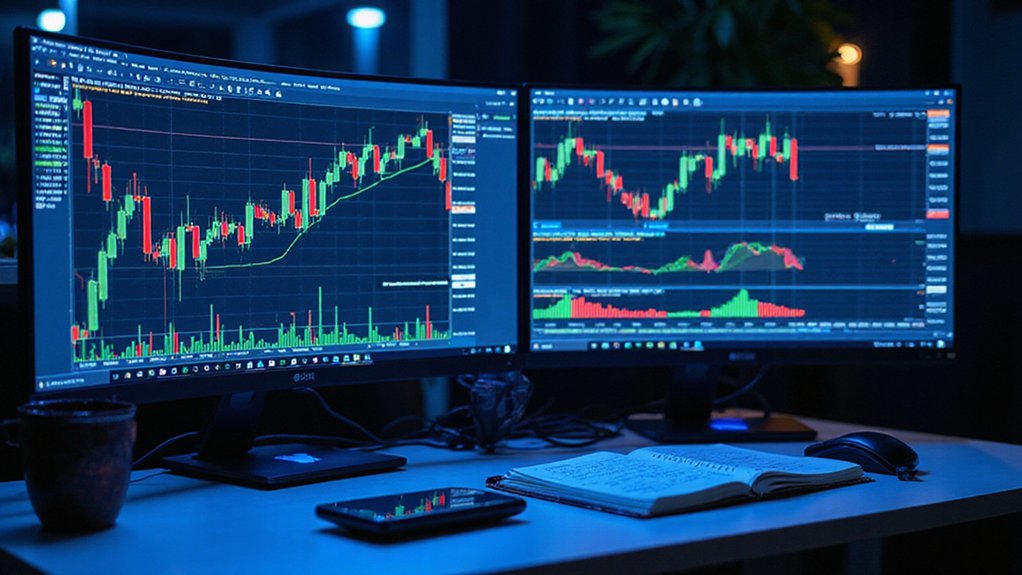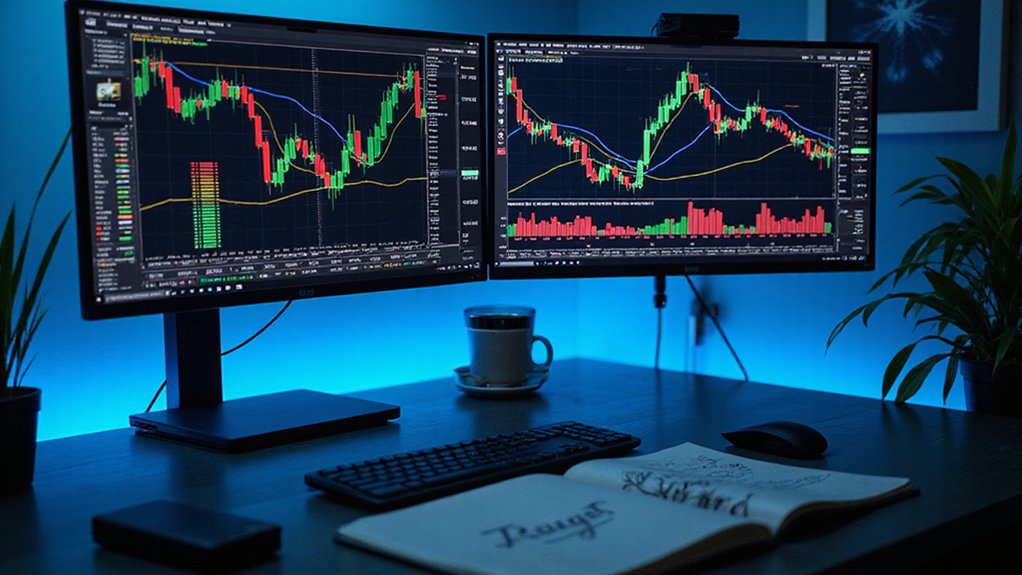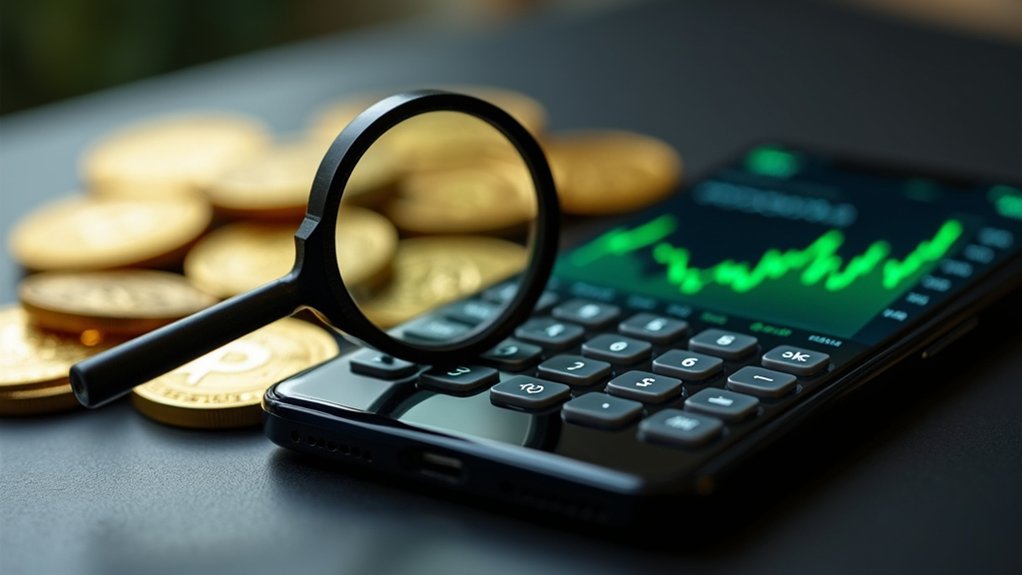Cryptocurrency day trading requires selecting a liquid exchange (Binance stands prominent), implementing rigorous technical analysis through candlestick patterns and moving averages, and—perhaps most vitally—adhering to strict risk management protocols. Successful traders limit position sizes to 1-2% of capital, set definitive stop-losses, and embrace the market’s 24/7 volatility while maintaining emotional discipline. This peculiar confluence of finance, technology, and psychology offers both intellectual stimulation and financial opportunity for those who approach it systematically.

Why has cryptocurrency day trading captivated the attention of both seasoned financial veterans and ambitious newcomers alike?
The answer lies in the unprecedented volatility of digital assets, which—unlike their traditional counterparts that slumber peacefully outside market hours—pulsate with profit potential 24 hours a day, seven days a week.
This perpetual accessibility creates a landscape where fortunes can materialize (or evaporate) while conventional traders are still contemplating their morning coffee.
Successful cryptocurrency day trading begins with selecting an appropriate exchange.
Platforms like Binance offer the requisite liquidity and diverse trading pairs essential for efficient execution.
After establishing an account—fortified with robust security measures including two-factor authentication—traders must familiarize themselves with the platform’s interface.
This preliminary groundwork, though seemingly mundane, forms the foundation upon which profitable trading strategies are built.
Technical analysis reigns supreme in the cryptocurrency trading domain.
Candlestick patterns reveal market psychology; moving averages illuminate trends; Bollinger Bands signal volatility contractions and expansions.
These tools, when wielded with precision, transform seemingly random price movements into decipherable patterns.
The 15-minute and hourly charts typically provide the ideal balance between noise and signal for day traders maneuvering these digital waters.
Understanding how to interpret support and resistance levels on crypto charts is essential for identifying potential entry and exit points in the market.
Risk management—perhaps counterintuitively—supersedes profit-seeking in importance.
Implementing stop-loss orders, establishing take-profit levels, and adhering to position sizing principles separates sustainable traders from statistical casualties.
The cryptocurrency market’s notorious volatility demands a disciplined approach to capital preservation. Experts recommend limiting exposure to no more than 1-2% of capital per trade to maintain longevity in this high-risk environment.
Diversification across trading pairs offers another layer of risk mitigation.
While Bitcoin remains the market’s gravitational center, altcoins often present more pronounced price movements—and consequently, greater profit potential for the discerning trader.
The cryptocurrency markets, with their libertarian underpinnings and technological complexity, represent a fascinating confluence of finance, technology, and human psychology.
For those willing to embrace the volatility while implementing rigorous analytical frameworks and risk management protocols, day trading these digital assets can provide both intellectual stimulation and financial reward.
Frequently Asked Questions
How Much Money Do I Need to Start Day Trading Cryptocurrency?
Starting day trading cryptocurrency typically requires between $10,000-$25,000 for effective risk management—though the ambitious might begin with as little as $1,000-$5,000 (albeit with severely constrained options).
While U.S. traders face the $25,000 PDT rule for margin accounts, crypto-specific platforms often circumvent this restriction.
The financially prudent, however, recognize that adequate capitalization—ideally $10,000+—provides the psychological buffer necessary to weather inevitable volatility without succumbing to emotional trading decisions.
What Tax Implications Should I Be Aware of When Day Trading?
Day traders face substantial tax complexities—every crypto-to-crypto trade creates a taxable event requiring calculation of gains or losses.
Short-term profits (assets held under a year) incur ordinary income rates up to 37%, while meticulous record-keeping becomes imperative for compliance.
The IRS’s heightened scrutiny of cryptocurrency makes documentation of transaction dates, cost bases, and sale prices non-negotiable.
Losses can offset gains (limited to $3,000 against ordinary income annually), offering minimal consolation in this convoluted regulatory landscape.
Can I Day Trade Cryptocurrency Part-Time While Working Another Job?
Part-time cryptocurrency day trading while employed elsewhere is technically feasible but statistically precarious.
The market’s notorious volatility demands attention that fragmented focus simply cannot provide, and with success rates already dismal for full-time traders (80-97% lose money), dividing one’s attention merely compounds the challenge.
Those determined to attempt this high-wire act should implement rigorous automation strategies, strict capital limits, and pre-defined entry/exit parameters—essentially acknowledging that part-time trading typically yields full-time stress with part-time results.
Which Cryptocurrency Exchanges Are Safest for Day Trading Beginners?
For beginners prioritizing safety in cryptocurrency day trading, Coinbase stands out with its robust security measures and intuitive interface—despite those eyebrow-raising fees.
Gemini’s regulatory compliance and Kraken’s security-liquidity balance offer compelling alternatives.
Binance.US provides cost efficiency while maintaining U.S. regulatory adherence, though using its feature-rich platform may overwhelm neophytes.
The prudent novice would do well to select an exchange that balances security guardrails with sufficient trading tools rather than maximizing feature density.
How Do I Develop a Risk Management Strategy for Cryptocurrency Trading?
Developing a cryptocurrency risk management strategy requires methodical construction rather than the haphazard approach many neophytes embrace (often to their financial detriment).
One should establish position sizing limits—adhering to the 1-2% rule is prudent—implement tiered stop-losses, and maintain favorable risk-reward ratios.
Emotional discipline trumps technical prowess; the finest algorithms collapse under the weight of FOMO.
Hardware wallets and two-factor authentication aren’t merely suggestions in a market where exchange vulnerabilities remain disconcertingly common.









